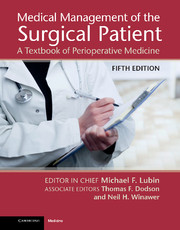Book contents
- Frontmatter
- Dedication
- Contents
- List of Contributors
- Preface
- Introduction
- Part 1 Perioperative Care of the Surgical Patient
- Part 2 Surgical Procedures and their Complications
- Section 17 General Surgery
- Section 18 Cardiothoracic Surgery
- Section 19 Vascular Surgery
- Chapter 81 Carotid endarterectomy
- Chapter 82 Abdominal aortic aneurysm repair: open
- Chapter 83 Abdominal aortic aneurysm repair: endovascular
- Chapter 84 Aortobifemoral bypass grafting
- Chapter 85 Treatment of femoropopliteal disease
- Chapter 86 Lower extremity embolectomy
- Chapter 87 Treatment of chronic mesenteric ischemia
- Chapter 88 Inferior vena cava filters
- Chapter 89 Portal shunting procedures
- Section 20 Plastic and Reconstructive Surgery
- Section 21 Gynecologic Surgery
- Section 22 Neurologic Surgery
- Section 23 Ophthalmic Surgery
- Section 24 Orthopedic Surgery
- Section 25 Otolaryngologic Surgery
- Section 26 Urologic Surgery
- Index
- References
Chapter 83 - Abdominal aortic aneurysm repair: endovascular
from Section 19 - Vascular Surgery
Published online by Cambridge University Press: 05 September 2013
- Frontmatter
- Dedication
- Contents
- List of Contributors
- Preface
- Introduction
- Part 1 Perioperative Care of the Surgical Patient
- Part 2 Surgical Procedures and their Complications
- Section 17 General Surgery
- Section 18 Cardiothoracic Surgery
- Section 19 Vascular Surgery
- Chapter 81 Carotid endarterectomy
- Chapter 82 Abdominal aortic aneurysm repair: open
- Chapter 83 Abdominal aortic aneurysm repair: endovascular
- Chapter 84 Aortobifemoral bypass grafting
- Chapter 85 Treatment of femoropopliteal disease
- Chapter 86 Lower extremity embolectomy
- Chapter 87 Treatment of chronic mesenteric ischemia
- Chapter 88 Inferior vena cava filters
- Chapter 89 Portal shunting procedures
- Section 20 Plastic and Reconstructive Surgery
- Section 21 Gynecologic Surgery
- Section 22 Neurologic Surgery
- Section 23 Ophthalmic Surgery
- Section 24 Orthopedic Surgery
- Section 25 Otolaryngologic Surgery
- Section 26 Urologic Surgery
- Index
- References
Summary
Endovascular repair of abdominal aortic aneurysms (EVAR) was introduced in the US market in 1999 and has gained rapid popularity because of decreased perioperative morbidity, shorter length of stay, and rapid recovery compared with open repair. Currently, more than 60% of AAAs are repaired endovascularly. However, there are possible issues of magnetic resonance imaging (MRI) compatibility. While all stent grafts cause image artifacts, the Zenith graft, made of ferro-magnetic stents, is incompatible with MRI. Also, there is increased cost with EVAR when compared with open repair.
The anatomic morphology of the aneurysm and the aortoiliac system proximal and distal to it is the most important criterion in determining if the patient is a candidate for EVAR.
Anatomic criteria for suitability for EVAR:
Proximal landing zone (the “neck”): The aortic wall immediately distal to the lowest renal artery and proximal to the aneurysm is the proximal landing zone. The instructions for use (IFUs) for current commercially available grafts specify that the “neck” should be at least 15mmlong; 40% of candidates for EVAR do not meet this criterion.
Distal landing zone: This is the seal area in the common or external iliac artery where the iliac limbs of the endograft end; it should be at least 10 mm.
Access vessels: Endovascular devices are inserted into the aorta from the groin, traversing retrograde through the common femoral and iliac arteries. To allow access without rupture, these vessels have to be a minimal diameter that varies according to each device manufacturer and the size of the endograft required.
Status of critical side branches: The endovascular approach entails occlusion of the inferior mesenteric artery, and may also require the sacrifice of one or more accessory renal or internal iliac arteries. The suitability and configuration of an endovascular approach is thus predicated by the adequacy of collateral supply and the acceptable extent of end-organ ischemia.
- Type
- Chapter
- Information
- Medical Management of the Surgical PatientA Textbook of Perioperative Medicine, pp. 611 - 614Publisher: Cambridge University PressPrint publication year: 2013

